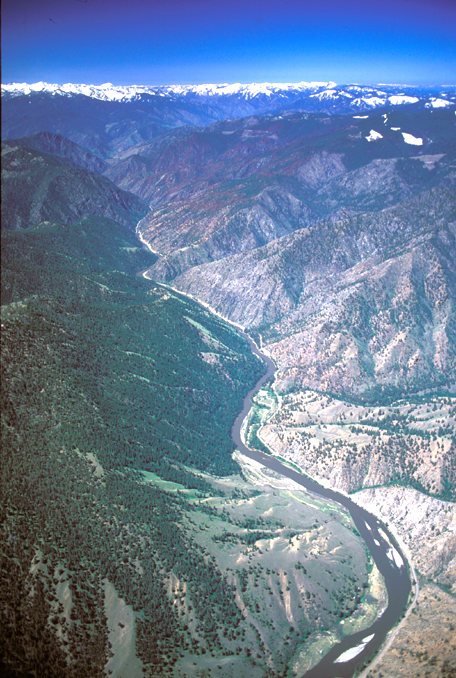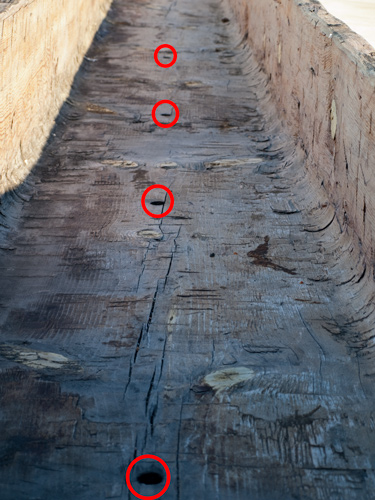Leaving his horses and most of his detachment behind, Clark and his guide Toby climb a mountain spur where they see the futility of canoeing the Salmon River, also known as the River of No Return.
At the request of Cameahwait, Lewis waits another day at Fortunate Camp before starting the portage over the Rocky Mountains. The dugouts are sunk in a nearby pond, and more Lemhi Shoshones arrive.
Sinking the Canoes
by Yellowstone Public Radio[1]Originally aired weekdays by Yellowstone Public Radio during the Bicentennial observance of 2003-2006. Narrated by Hal Hansen. Scripts by Whit Hansen and Ed Jacobson. Produced by Leni Holliman. © … Continue reading
River of No Return (Salmon River)
To see labels, point to the image.
© 2001 Airphoto, Jim Wark. All rights reserved.
Clark: River of No Return
Difficult Portages
The mountains Close So Clost as to prevent a possibility of a portage with great labour in Cutting down the Side of the hill removeing large rocks &c. &c. all the others may be passed by takeing every thing over Slipery rocks, and the Smaller ones Passed by letting down the Canoes empty with Cords, as running them would certainly be productive of the loss of Some Canoes
—William Clark
Not Enough Provisions
running them would certainly be productive of the loss of Some Canoes, those dificuelties and necessary precautions would delay us an emince time in which provisions would be necessary. (we have but little and nothing to be precured in this quarter except Choke Cheres & red haws not an animal of any kind to be seen and only the track of a Bear)
—William Clark
Clark’s View
assended a Spur of the Mountain from which place my guide [Toby] Shew me the river for about 20 miles lower & pointed out the difficulty . . . . those rapids which I had Seen he said was Small & trifleing in comparrison to the rocks & rapids below, at no great distance & The Hills or mountains were not like those I had Seen but like the Side of a tree Streight up—
—William Clark
Dugout Canoe with Gauge Holes
© 2008 by Kristopher K. Townsend. Permission to use granted under the Creative Commons Attribution-Share Alike 4.0 International license.
Gauge holes, circled in the above photo, are used during canoe construction to determine the required thickness of the hull. They are plugged with a dowel after the canoe has been dug out.
Lewis: Waiting for More Help
Sinking the Canoes
I also laid up the canoes this morning in a pond near the forks; sunk them in the water and weighted them down with stone, after taking out the plugs of the gage holes in their bottoms; hoping by his means to guard against both the effects of high water, and that of the fire which is frequently kindled in these plains by the natives. the Indians have promised to do them no intentional injury and beleive they are too lazy at any rate to give themselves the trouble to raise them from their present situation in order to cut or birn them.
—Meriwether Lewis
Entertaining Chase
the Indians pursued a mule buck near our camp I saw this chase for about 4 miles it was really entertaining, here were about twelve of them in pursuit of it on horseback, they finally rode it down and killed it . . . . this mule buck was the largest deer of any kind I had ever seen.
—Meriwether Lewis
More Shoshones Arrive
at three P. M. the expected party of [Lemhi Shoshone] Indians arrived, about 50 men women and Children. I now learnt that most of them were thus far on their way down the valley towards the buffaloe country, and observed that there was a good deel of anxiety on the part of some of those who had promised to assist me over the mountains to accompany this party
—Meriwether Lewis
Weather Diary
State of the Thermometer at rise
Weather at rise
Wind at rise
State of the Thermometer at 4 P.M. Weather at 4 P.M. Wind at 4 P.M. 35 [above 0] fair E. 72 [above 0] fair S E white frost this morning
—Meriwether Lewis[2]To assist the reader, the editor of this web page has omitted the date column and spelled out some abbreviations.
Notes
| ↑1 | Originally aired weekdays by Yellowstone Public Radio during the Bicentennial observance of 2003-2006. Narrated by Hal Hansen. Scripts by Whit Hansen and Ed Jacobson. Produced by Leni Holliman. © 2003 by Yellowstone Public Radio. |
|---|---|
| ↑2 | To assist the reader, the editor of this web page has omitted the date column and spelled out some abbreviations. |
Experience the Lewis and Clark Trail
The Lewis and Clark Trail Experience—our sister site at lewisandclark.travel—connects the world to people and places on the Lewis and Clark Trail.
Discover More
- The Lewis and Clark Expedition: Day by Day by Gary E. Moulton (University of Nebraska Press, 2018). The story in prose, 14 May 1804–23 September 1806.
- The Lewis and Clark Journals: An American Epic of Discovery (abridged) by Gary E. Moulton (University of Nebraska Press, 2003). Selected journal excerpts, 14 May 1804–23 September 1806.
- The Lewis and Clark Journals. by Gary E. Moulton (University of Nebraska Press, 1983–2001). The complete story in 13 volumes.



